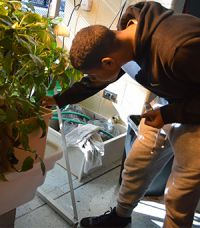Jayden Irish used a cotton swab to pollinate a flowering plant. The Kelloggsville Middle School seventh-grader will soon be rewarded with the fruits of his labor: tomatoes, but for now he’s thinking about the future of indoor gardening.
In the classroom’s climate-controlled garden, Jayden explained why hydroponics, growing plants without soil, is important for the planet. Planting vertically saves a lot of land, he said.

The school’s hydroponic gardening program gives students a real-world example of how a pesticide-free, year-round yield of plants can help feedthe planet. “We learn how we get our food, and where our food comes from,” Jayden said.
The program, funded through a State Farm service-learning grant for sustainable urban agriculture projects, has grown over the past few years to include flourishing indoor gardens at each grade level, a fish pond where tilapia waste returns to plants as fertilizer, and a bounty of fresh peppers, cilantro, basil and ripe red tomatoes can be sent home with students.
“A 4-foot-by 4-foot garden like this could feed a family of four,” said Bridgette Ujlaky, owner of Horizen Hydroponics, who works with Kelloggville students and teachers on their program.
Green Learning Opportunities
Cross-curricular lessons are perfect for budding scientists, engineers, chemists and even chefs, said seventh-grade science teacher Lynnea Roon. Students have learned pollination, transpiration, plant parts, photosynthesis and weather and humidity, all in the classroom garden.
In Marcia Cisler’s eighth-grade classroom, students stay busy tending plants by checking pH level and electro-conductivity, as well as trimming and harvesting the plants. Ten tilapia live in an aquaponics system, creating a symbiotic relationship with the gardens. Water from the fish pond is fed to the plants, which provides nutrients. The water is recirculated back to the aquaculture system.
“It’s cool. The fish and plants help each other out,” said eighth-grader Mykal Green.

Ujlaky visits regularly to help tend the gardens with students and teach them about the system. She and her husband, John Ujlaky, have made it their mission to educate people about indoor gardening and help it become a mainstream part of kindergarten-through high-school education.
Traditional farming and over-spraying can lead to soil depletion and require a lot more water than with hydroponics, she said, where crops can grow year-round.
“The commercial applications for hydroponics really are the future of farming,” Ujlaky said. “In bringing this type of program into schools, we are giving them a skill set they can use for future work development and opportunities.”









